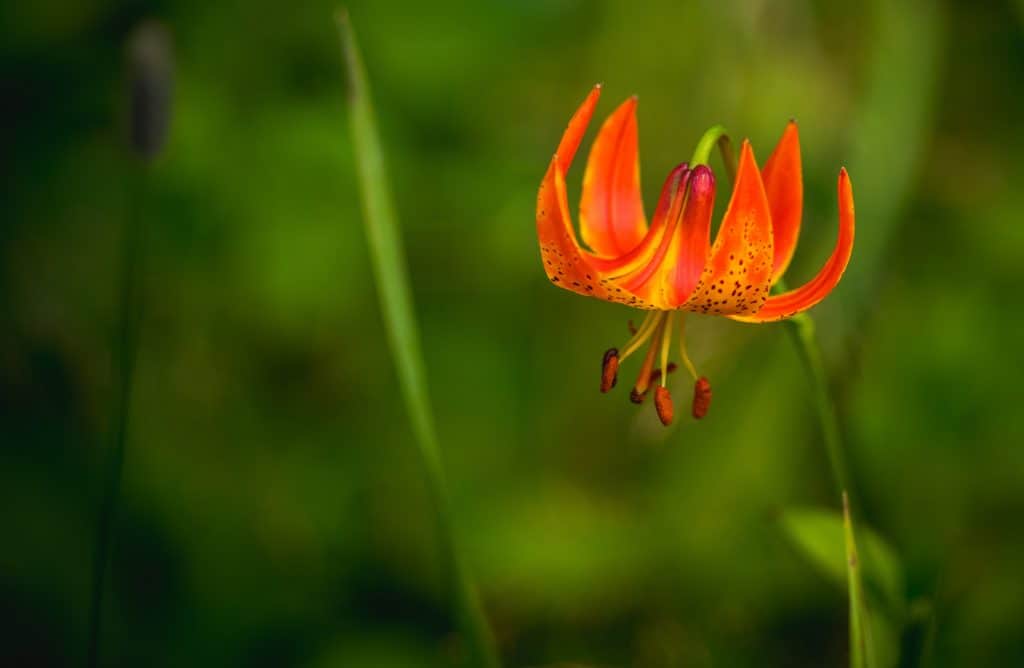The Michigan Lily is an exquisite and beautiful flower that can add a splash of colour to your garden, but don’t let the name confuse you- Michigan Lilies are native to Ontario.
The beautiful Michigan Lily (Lilium michiganense) is a perennial plant which can become as tall as 5 inches. The Michigan Lily leaves are elliptic in shape and smooth along their margins; the leaf venation is parallel. The upper leaf surface is medium green whilst the lower leaf surface is light-medium or whitish green. The leaves usually occur in whorls of three to seven along the stem, although some of the upper leaves may occur in pairs or they may alternate individually.
The Michigan Lily has large, bright flowers that will brighten up your garden in the summer months. The Michigan Lily flower consists of six tepals, six stamens, and a pistil with a single style. The tepals are yellow/orange to orange-red, purple-spotted, lanceolate in shape, and strongly curve back towards the flower base. The stamens are strongly exserted and slightly spreading; their filaments are light green to nearly white, while their anthers are reddish brown. The style is strongly exserted and curved slightly upward; it is light yellow to nearly white, except toward the tip, where it is tinted yellow to orange/red. The Michigan Lily can have one to eight flowers in a whorl at the top of the plant, each flower at the end of a long naked stalk. The blooming period occurs from early to mid-summer, lasting about one month. Afterwards, the flowers are replaced by seedpods. The thin papery wings enable the seeds to be carried some distance by the wind. The root system consists of a yellow bulb with fibrous roots below.
The Michigan Lily can sometimes be confused with the also beautiful Tiger Lily: while the flowers do bear a clear resemblance, the leaves are distinctly different. Unlike the alternate leaves of the Tiger Lily, the Michigan Lily has leaves that whorl around the stem. The seedpods are also different. Where the tiny round bulbets of the Tiger Lily grow around a hairy stem, the native Michigan Lily seedpods form at the tip of the stalk in place of the blossom. They are white, three-lobed pods which contain flat seeds with thin papery wings.

Michigan Lily Care
Michigan Lilies are simple to grow, and, in most climates, they will be happy to come back in the following year. Give them the best start you can, and they can reward you with their glorious blooming!
So, how do you start growing lilies? You’ll need to consider placement, disease prevention, and feeding. First, let’s look at where to plant lily bulbs or seeds.
The Michigan Lily’s preference is full to partial sun, loamy soil or sandy loam, and moist conditions. They are great to plant on a border of a garden or pond where they can meet both conditions. It is imperative to plant your lilies in a location that drains well. As you choose a spot for your Michigan Lily bulbs, consider the following:
Soil drainage
Lilies don’t like to have wet roots so choose a location that dries out quickly and isn’t set in a low-lying part of your landscape. You can try well-drained soil such as a sand-peat moss-loam mix with a gravelly bottom.
Soil pH
like most perennials-lilies, the Michigan Lily prefers a pH of 6.5 to 7. The hardness of the soil must be between 4-8 in Winter.
Light
Lilies require at least six to eight hours of sunlight each day. With less sun, their stems may become floppy and weak.
Spacing
Make sure to give your flowers room to grow. Double-check their descriptions and consider both height and width when figuring out spacing, as these plants prefer not to be crowded. Since Michigan Lilies tend to naturally grow in clumps, consider planting a grouping together for a naturalized look.
How does Michigan lily spread?
Michigan Lilies require cross-pollination for fertile seeds. Cross pollination can be carried out by wind, insects, or animals. Fortunately, the large showy flowers attract hummingbirds and larger day-flying insects, such as Sphinx moths, Hummingbird moths, and the larger butterflies. If you wish to cultivate the Michigan Lily from seeds, bear in mind that this can be slow and difficult. You can start by collecting the seeds six to eight weeks after blooming, when the capsules have turned brown and begun to split- store the seeds in sealed and refrigerated containers. To propagate by seed, layer the seed in dampened moist in a sealable container. Seal and store at room temperature for six to eight weeks. Small bulblets will develop. A good rule to keep in mind is to plant bulbs with their bottoms resting at a depth three times the diameter of the bulb. For best results, plant Michigan Lilies 6-9 inches deep and space approximately 8 inches apart. Lilies never go completely dormant so make sure they don’t dry out. Avoid fertilizers containing excessive nitrogen. Organic fish fertilizer is the perfect nutrient source for lilies. Mulch with several inches of organic compost or shredded bark to keep the soil cool and moist. The growth rate for Michigan Lily is moderate.
Michigan Lily is found in higher quality natural areas. The Michigan Lily is becoming more uncommon in the wild due to roadside mowing and cultivation. So, if you spot these lilies growing on your property, please let them stand undisturbed until the plants become dormant in the fall!
Problems Growing Michigan Lily
Unfortunately, even if you plant Michigan Lily in the best possible condition, they can still be subjected by common pest and diseases which are common of all lily species. For example, some insects feed destructively on lilies. The most famous (or infamous) one is the Lily beetle. This insect is capable of feeding on lily leaves, in some cases stripping the plant completely. The adult lily beetle is approximately 6-8mm long and is shiny, bright red with black antennae, head, legs and underside. Larvae are slug-like, varying in colour from yellow and orange to brown or green with black heads. Control of these insects is challenging. For small infestations, hand control may be the best option. The are some chemicals available, however the reports of efficacy vary greatly.
Fungal disease is also a threat and can occur if the soil is not able to drain water easily, as fungal pathogens prefer moist, warm conditions and during times of persistent moisture that fungal diseases become more prevalent. The use of high nitrogen fertilizers causes lush, soft tissue which makes it easier for the pathogen to infect the plant. Damaged bulbs or leaves can provide a physical opening through which the pathogen enters the plant. The two most serious fungal diseases of lilies are botrytis and basal rot.
- Botrytis affects the above ground portion of lily plants – leaves, stems, and can progress to flowers and buds. If the bulb is not affected the plant can regrow the next year. If the disease is present for three or more years in a row, the plant may unfortunately die. The disease begins with small light spots on the leaves usually starting at the bottom of the stem. The spots expand becoming darker in the center and lighter on the margins. Greyish mould may occur, and eventually the entire leaf is affected, becoming thin and brittle then falling off. The stem can also be affected causing the plant to collapse. To minimize the chances of getting botrytis avoid overhead watering and water early in the day. Mulch may help minimize rain splashing up from the soil which can spread the spores and good air circulation will allow foliage to dry quickly. Fungicidal sprays can be applied to help prevent the disease from becoming established. Bordeaux mixture is commonly recommended – a combination of copper sulphate (prevents germination of fungal spores) and slaked lime.
- Basal rot affects the base of the bulb from which the roots develop downwards, and to which the leaves are attached. The soil born fungus enters through the root and works its way up the plant. Spores are carried in the soil or on infected plant tissues and can be spread by tools, infected bulbs and even potting soil. The main symptoms are yellowing of the leaves, stunting of growth and in some cases premature death of the plant. Below ground, a dark brown rot is seen on the bulb parts and the roots may die. Underground bulblets may be infected, but above ground stem bulblets should be healthy and in fact may be produced in larger numbers. These can be harvested for replanting, but be sure to pick a new location, as the organism can live in the soil for years even without a host. It’s also possible to save the bulb by removing the infected scales and then dipping the bulb in a fungicide solution.
Where to Find Michigan Lily for Sale?
Michigan Lilies are available to buy online. Prices vary depending on whether you are interested in buying either seeds, bulbs or a grown plant.
Seeds can start for as little as five dollars, while the average price for the plant is 30 dollars.
